Museums in Istanbul
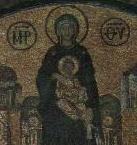
|
The Basilica of St. Sophia, now called the Ayasofya Museum (click here to see interior picture) is unquestionably one ot the finest buildings of all time. Built by Constantine the Great and reconstructed by Justinian in the 6th century, its immense dome rises 55 meters above the ground and its diameter spans 31 meters. You should linger here to absorb the building's majestic serenity and to admire the fine Byzantine mosaics. (Open every day except Monday.)
|
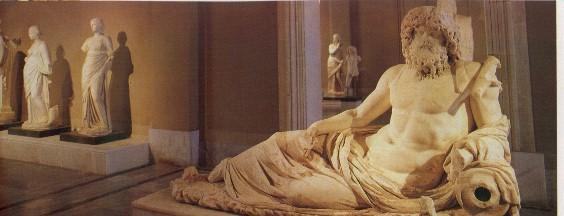
Interior, Istanbul Archeological Museum
The Archaeological Museums are found just inside the first court of Topkapi Palace. The newly renovated Archaeological Museum includes the celebrated Alexander Sarcophagus among its treasures of antiquity. The Museum of the Ancient Orient displays artifacts from the Sumerian, Babylonian. Assyrian, Hatti and Hittite civilizations. (Open every day except Monday.)
Originally built as a kosk or pavilion by Mehmet the Conqueror in the 15th century, the Cinili Kosk. which houses the Museum of Turkish Ceramics. contains beautiful lznik wares from the 16th century and fine examples of Seljuk and Ottoman pottery and tiles. (Open every day except Monday.)
|
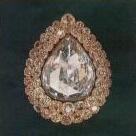
Kasikci Diamond
in Topkapi Palace
|
|
|
Like the Ayasofya Museum, the St. Irene Museum was originally a church. It ranks, in fact, as the first church built in Istanbul.Constantine commissioned it in the fourth century and Justinian later had the church restored. Reputedly the building stands on the site of a pre-Christian temple. (Open every day except Monday.)
|
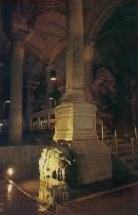
Yerebatan Palace
|
The dark stone building that houses the Museum of Turkish and Islamic Art was built in 1524 by Ibrahim Pasa, Grand Vizier to Suleyman the Magnificent, as his residence. It was the grandest private residence ever built in the Ottoman Empire. Today it holds a superb collection of ceramics, metalwork, miniatures, calligraphy, textiles, and woodwork as well as some of the oldest carpets in the world. (Open every day except Monday.)
Across the street from the Ibrahim Pasa Palace is the Museum of Turkish Carpets which contains exquisite antique carpets and kilims gathered from all over Turkey. (Open every day except Sunday and Monday.)
Near St. Sophia is the sixth century Byzantine cistern known as the Yerebatan Sarayi. Three hundred and thirty-five massive Corinthian columns support the immense chamber's fine brick vaulting. (Open every day except Tuesday.)
|
The Mosaic Museum preserves in situ exceptionally fine mosaic pavements of the fifth and sixth centuries which remain from the Great Palace of the Byzantine emperors. (Open every day except Monday.)
The 11th century church of St. Savior in Chora, the Kariye Museum, is, after St. Sophia, the most important Byzantine monument in Istanbul. Unremarkable in its architecture, inside tne walls are decorated with superb l4th century frescoes and mosaics. Illustrating scenes from the life of Christ and the Virgin Mary, these brilliantly colored paintings embody the vigor of Byzantine art. Restored wooden houses in the area surrounding the churcn offer tea and coffee in a relaxed atmosphere far removed from the city's hectic pace. (Open every day except Tuesday.)
|
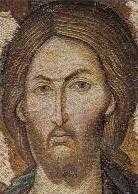
Mosaic From
Kariye Museum
|
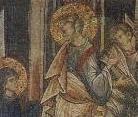
Mosaic from
Kariye Museum
|
The Aviation Museum in Yesilkoy traces the development of air flight in Turkey. (Open every day except Monday.)
The great field tents used by the Ottoman armies on campaigns are displayed in the Military Museum. Other exhibits include Ottoman weapons and the accoutrements of war. The Mehter Takimi (Ottoman military band) perform Ottoman Marshal music between 3:00 and 4:00 p.m. (Open every day except Monday and Tuesday.)
The house in which Ataturk lived in sisli now serves as the Ataturk Museum and displays his personal effects. (Open every day except Saturday and Sunday.)
|
In the Besiktas district the Naval Museum displays the great imperial caiques in which the sultans were rowed across the Bosphorus, as well as many other interesting exhibits of Ottoman naval history (Open every day except Monday and Thursday.)
Also in Besiktas, the Museum of Fine Arts displays Turkish paintings and sculptures from the end of the 19th century to the present day. (Open every day except Monday and Tuesday.)
Near the gardens of Yildiz Palace, the City Museum preserves and documents the history of Istanbul since the Ottoman conquest. (Open every day except Thursday.)
Up the Bosphorus in the picturesque village of Buyukdere, the collections of the Sadberk Hanim Museum fill two charming 19th century wooden villas. A private museum which originally displayed Turkish decorative arts, it has recently been expanded with a new collection of archaeological finds. (Open every day except Wednesday.)
|

|

|
 
This site prepared by Tayfun Kalyoncu on 28.02.1997 and last updated on 01.05.1999.
For any comments and suggestion please send an e-mail using the form at page mailform.html
|





